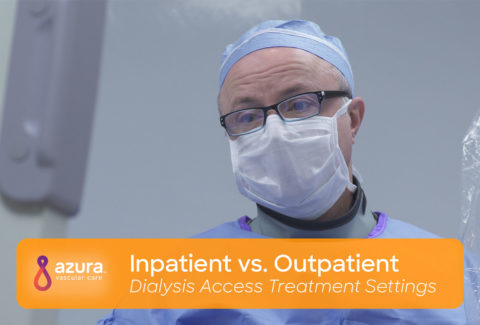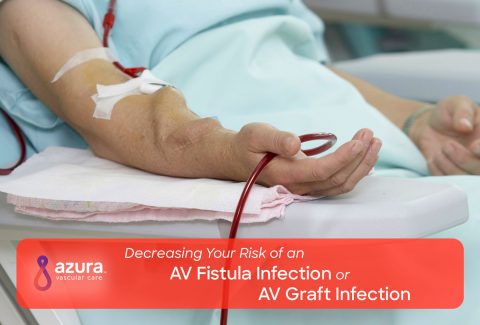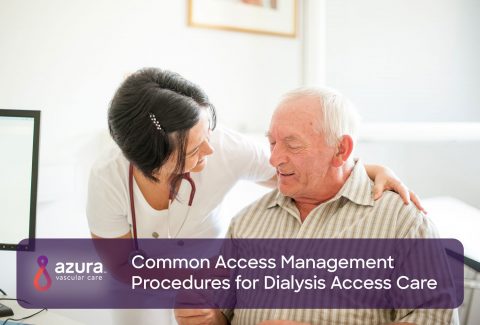
When your kidneys are healthy, they clean your blood. But when they fail, you need treatment to replace the work your kidneys used to do. Unless you have a kidney transplant, you will need dialysis.
Hemodialysis is most successful if your access is functioning well. But what happens when you have an issue with your fistula, graft or catheter? The most common access problems are infection and low blood flow due to narrowing or blood clotting in the arteriovenous (AV) access. (i) Narrowing, also known as stenosis, can lead to clot formation, which will reduce the overall effectiveness of your dialysis treatments, and eventually, blood flow through the access may stop.
A vascular access center is an outpatient facility that provides the crucial care and maintenance needed to preserve or restore function to AV vascular accesses for dialysis patients. Some vascular access centers may also offer treatments for other vascular conditions, including uterine fibroids, varicoceles, varicose veins, peripheral artery disease and more.
Why Choose a Vascular Access Center?
If you are experiencing problems with your access, your nephrologist may refer you to a vascular specialist for evaluation. The vascular specialist will determine if you need an interventional procedure to ensure you leave with a fully functioning access.
Although you have the option to see a hospital-based specialist, vascular access centers offer specialized, dedicated vascular care in a safe and supportive environment. What is meant by a vascular access center is that it’s a specialized center where a team of credentialed, highly trained vascular specialists, registered nurses and technicians provide state-of-the-art, minimally-invasive treatments for dialysis access, adhering to the same rigorous standards and benchmarks as a hospital setting.
What to Expect During Your Visit
There are several minimally-invasive procedures to treat a dysfunctional access and get you back to your regular dialysis treatments.
 It’s important to contact the vascular access center for specific instructions to prepare for your dialysis access procedure. In general, be sure to do the following:
It’s important to contact the vascular access center for specific instructions to prepare for your dialysis access procedure. In general, be sure to do the following:
- Bring photo identification and your insurance card.
- Provide a list of the prescription and over-the-counter medications you take, including dosage and frequency.
- Do not eat or drink anything, including water, alcohol, gum or mints in the specified time frame as instructed by your doctor.
- You may be sore from your procedures or have bandages, so wear clothes that are comfortable and loose.
- Do not wear jewelry to your appointment.
- If you take medications for your heart, blood pressure, or lungs, follow specific instructions from your doctor prior to your AV access intervention. If you develop a cold, persistent cough, sore throat, fever or any other illness two days prior to surgery, notify your doctor.
- You may receive some medications that may make you drowsy for about 24 hours. Therefore, it is important to bring someone with you who can drive you home.
- You will be moved to a recovery area after your procedure. Your breathing and heart function will continue to be monitored. Once the determination is made that your vital signs are stable and your overall condition is back to normal you will be discharged to your home.
An average vascular access procedure takes about 45 to 60 minutes.
Understanding the Terminology and Procedures for Dialysis Access Management
If your graft or fistula is clotted, vascular specialists use a variety of procedures to dissolve or remove the clot. First, X-ray pictures called fistulograms are taken to see where the narrowing (stenosis) is occurring. Fluoroscopy—an X-ray procedure that produces real-time video images of internal organs and blood vessels will be used.
Then, a balloon may be inserted to open the narrowed or blocked area in the vein. This procedure is called a balloon angioplasty. A clot can be treated either with thrombolysis, where a catheter is used to inject medicine into a blood clot to dissolve it or with thrombectomy, where a catheter and/or a mechanical device that breaks the clot into very small pieces is used to remove the clot.
If angioplasty is unsuccessful, a small metal tube called a stent can be inserted to keep the artery or vein open, depending on the location of the narrowing. When angioplasty is unsuccessful, a patient may be referred to a surgeon for a procedure called a revision of the graft or fistula.
When to Call Your Doctor
If you suspect an issue with your vascular access, particularly if you experience bleeding, redness, swelling, soreness, pain, warmth, or pus around the site, contact your doctor immediately. (ii)
For more information call 866-996-9729 to schedule an appointment with a vascular specialist.
Sources:
(i) The National Institute of Diabetes and Digestive and Kidney Diseases Health Information Center. (2018, January 01). Hemodialysis. Retrieved September 24, 2018, from https://www.niddk.nih.gov/health-information/kidney-disease/kidney-failure/hemodialysis
(ii) Latif, W. (2018, January 16). Dialysis centers – what to expect: MedlinePlus Medical Encyclopedia. Retrieved September 23, 2018, from https://medlineplus.gov/ency/patientinstructions/000706.htm


